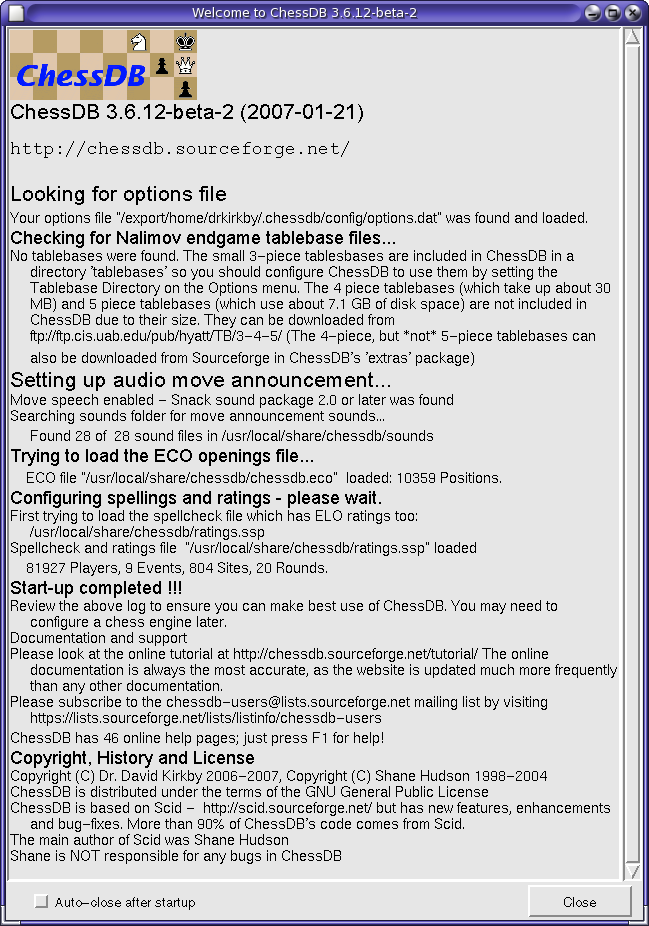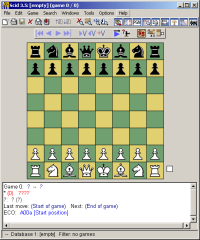2.2: Getting Started
This section will show you how to start ChessDB (assuming you have already installed it) and guide you around the main ChessDB window.
Starting ChessDB
After you have installed it correctly, you should have an executable file called called chessdb.exe in the C:\Program Files\ChessDB\bin directory if use Windows, or chessdb in /usr/local/bin (or similar) if you use Linux/UNIX. Run this program to start ChessDB.
When ChessDB starts, you will first see a window called the Startup window. It provides information about what extra files were found or databases were loaded when ChessDB started. It also has information about how to subscribe to the chessdb-users@lists.sourceforge.net mailing list.

You should check to ensure that ChessDB is loading the following items. None are essential, but all are useful - especially the ECO classification file. They are listed in an approximate order of usefulness, so you should pay more attention to making sure the first few are right.
- The ECO classification file (called chessdb.eco) should be found. This is very important. You might need to configure ChessDB to find this file, but it should be found okay. It can be loaded by going to the Options menu and selecting Load ECO File You might need to set this up. The file is included with your distribtion of ChessDB.
- The spellcheck file (ratings.ssp or spelling.ssp) could usefully be used to check the spellings on your game in your databases.
- The endgame table bases should be loaded. The 3-piece table bases are included in all ChessDB installation, so they should be found. If you want to use the 4-piece table bases, yhou should download a version of ChessDB that has them. It adds about 30 MB to the size of ChessDB, so it is not included with all downloads. If you want the 5-piece endgame tablebases, then you can download them from the crafty ftp site but be aware the 5-peice ones take up 7.1 GB.
- Move annoucements - if you want the audio annoucements of moves, ChessDB needs to find the audio (.wav files) and the 'snack' sound package. The WAV files for the sounds must be found by the ChessDB executable (they are included in your distribution). The 'snack' audio package must also be found for audio to work. This is included in the Windows setup.exe that is distributed, but it is not for the UNIX/Linux systems. (You can download 'snack' for UNIX/Linux from http://www.speech.kth.se/snack/index.html).
Once you are sure these are all set up and working, you can then usually ignore the Starup window and close it - it can also be configured to close itself. But the startup window is useful when you first install ChessDB, to ensure you are getting the full functionality.
The Main Window
 Next, the main window will appear; a reduced image of it is shown here.
The largest part of the main window is the chessboard.
You will probably want to resize the board to your monitor size and
video settings; the next section explains
how to do this, along with changing the board colours, fonts and other
settings.
Next, the main window will appear; a reduced image of it is shown here.
The largest part of the main window is the chessboard.
You will probably want to resize the board to your monitor size and
video settings; the next section explains
how to do this, along with changing the board colours, fonts and other
settings.
ChessDB follows a multi-window design that may seem unusual to Windows users at first, but it is simple and clean. ChessDB aims to provide powerful database features with minimal user interface complexity.
Menus
Most major functions in ChessDB can be accessed from the main window menu bar. Browse the menus now to see the range of features and get used to where each type of action is located in the menu hierarchy. Note that ChessDB uses the following graphical user interface guidelines:
- Menus are not too long, and related commands are grouped together.
- Commands that are not currently valid (perhaps because no database is open, for example) are disabled (shaded out).
- Many commands have a Ctrl+key or Ctrl+Shift+key shortcut sequence.
- As you move over a menu command, a fuller explanation of its action is displayed in the status bar at the bottom of the main window.
- Commands that produce a dialog box before they commence an operation have three dots (...) after their name. This means you can try any menu command ending in "..." confident that it will not do anything to alter your data without further interaction.
Toolbars
The main window contains a toolbar just below the menu bar, with icons for fast access to commonly used actions such as loading databases, searching for games, and opening or closing additional ChessDB windows. The leftmost icons should look fairly standard (they are for creating, opening and saving files) but the others will be specific to ChessDB. When you move the mouse over a toolbar icon, its action is explained in the status bar at the bottom of the main window. The toolbar can also be customized, as explained in the next section.
 Below that toolbar is one with buttons like those shown here.
This bar (called the navigation bar) contains icons for
moving about in the game that ChessDB is currently displaying.
When you start ChessDB, most buttons will be disabled (shaded) because the
current game is empty; it does not have any moves.
Below that toolbar is one with buttons like those shown here.
This bar (called the navigation bar) contains icons for
moving about in the game that ChessDB is currently displaying.
When you start ChessDB, most buttons will be disabled (shaded) because the
current game is empty; it does not have any moves.
The Game Information Area
The area below the chessboard is called the game information area. It has a white background and shows you information about the current game (its players, date, result, etc), and which position from the game is displayed in the chessboard. A right-mouse click in this area produces a popup menu with customization options.
The Status Bar
Finally, there is a status bar at the very bottom of the window with information about the current database. This includes whether the current game has been edited and the name of the current database (if one is open).
The leftmost symbol in the status bar deserves mention. If the current game cannot be edited (e.g. because it is from a read-only file), the symbol appears as "%%". Otherwise, it is "--" if the game is unedited or "XX" if the game has unsaved changes.
When you move over a toolbar icon or menu item, the status bar will change to show a description of that icon or menu item. Move the mouse cursor over some of the toolbar icons (and some menu items) to see what they do.
If you would like to contribute to the tutorial or see anything that should be updated, corrected or improved, please contact David Kirkby. But please note David only speaks English.

Website administered by Dr. David Kirkby
This page was last modified: September 16, 2007. 10:41:41 am GMT